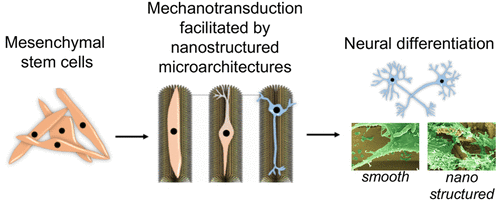当前位置:
X-MOL 学术
›
Nano Lett.
›
论文详情
Our official English website, www.x-mol.net, welcomes your
feedback! (Note: you will need to create a separate account there.)
Three-Dimensional Nanostructured Architectures Enable Efficient Neural Differentiation of Mesenchymal Stem Cells via Mechanotransduction
Nano Letters ( IF 9.6 ) Pub Date : 2018-10-10 00:00:00 , DOI: 10.1021/acs.nanolett.8b03313 Mahla Poudineh 1 , Zongjie Wang 1 , Mahmoud Labib 1 , Moloud Ahmadi 1 , Libing Zhang 1 , Jagotamoy Das 1 , Sharif Ahmed 1 , Stephane Angers 1 , Shana O. Kelley 1, 2, 3
Nano Letters ( IF 9.6 ) Pub Date : 2018-10-10 00:00:00 , DOI: 10.1021/acs.nanolett.8b03313 Mahla Poudineh 1 , Zongjie Wang 1 , Mahmoud Labib 1 , Moloud Ahmadi 1 , Libing Zhang 1 , Jagotamoy Das 1 , Sharif Ahmed 1 , Stephane Angers 1 , Shana O. Kelley 1, 2, 3
Affiliation

|
Cell morphology and geometry affect cellular processes such as stem cell differentiation, suggesting that these parameters serve as fundamental regulators of biological processes within the cell. Hierarchical architectures featuring micro- and nanotopographical features therefore offer programmable systems for stem cell differentiation. However, a limited number of studies have explored the effects of hierarchical architectures due to the complexity of fabricating systems with rationally tunable micro- and nanostructuring. Here, we report three-dimensional (3D) nanostructured microarchitectures that efficiently regulate the fate of human mesenchymal stem cells (hMSCs). These nanostructured architectures strongly promote cell alignment and efficient neurogenic differentiation where over 85% of hMSCs express microtubule-associated protein 2 (MAP2), a mature neural marker, after 7 days of culture on the nanostructured surface. Remarkably, we found that the surface morphology of nanostructured surface is a key factor that promotes neurogenesis and that highly spiky structures promote more efficient neuronal differentiation. Immunostaining and gene expression profiling revealed significant upregulation of neuronal markers compared to unpatterned surfaces. These findings suggest that the 3D nanostructured microarchitectures can play a critical role in defining stem cell behavior.
中文翻译:

三维纳米结构可通过机械转导实现间充质干细胞的高效神经分化
细胞形态和几何形状会影响细胞过程,例如干细胞分化,这表明这些参数可作为细胞内生物过程的基本调节剂。因此,具有微观和纳米地形特征的分层体系结构提供了用于干细胞分化的可编程系统。然而,由于具有合理可调的微观和纳米结构的制造系统的复杂性,有限的研究已经探索了分层体系结构的影响。在这里,我们报告三维(3D)纳米结构的微体系结构,有效地调节人类间充质干细胞(hMSCs)的命运。这些纳米结构可大大促进细胞排列和有效的神经源性分化,其中超过85%的hMSC表达微管相关蛋白2(MAP2),在纳米结构表面培养7天后,成熟的神经标记物。值得注意的是,我们发现纳米结构表面的表面形态是促进神经发生的关键因素,而高度尖刺的结构则促进了更有效的神经元分化。免疫染色和基因表达谱分析显示,与无图案的表面相比,神经元标记物显着上调。这些发现表明,3D纳米结构微体系结构可以在定义干细胞行为中发挥关键作用。免疫染色和基因表达谱分析显示,与无图案的表面相比,神经元标记物显着上调。这些发现表明,3D纳米结构微体系结构可以在定义干细胞行为中发挥关键作用。免疫染色和基因表达谱分析显示,与无图案的表面相比,神经元标记物显着上调。这些发现表明,3D纳米结构微体系结构可以在定义干细胞行为中发挥关键作用。
更新日期:2018-10-10
中文翻译:

三维纳米结构可通过机械转导实现间充质干细胞的高效神经分化
细胞形态和几何形状会影响细胞过程,例如干细胞分化,这表明这些参数可作为细胞内生物过程的基本调节剂。因此,具有微观和纳米地形特征的分层体系结构提供了用于干细胞分化的可编程系统。然而,由于具有合理可调的微观和纳米结构的制造系统的复杂性,有限的研究已经探索了分层体系结构的影响。在这里,我们报告三维(3D)纳米结构的微体系结构,有效地调节人类间充质干细胞(hMSCs)的命运。这些纳米结构可大大促进细胞排列和有效的神经源性分化,其中超过85%的hMSC表达微管相关蛋白2(MAP2),在纳米结构表面培养7天后,成熟的神经标记物。值得注意的是,我们发现纳米结构表面的表面形态是促进神经发生的关键因素,而高度尖刺的结构则促进了更有效的神经元分化。免疫染色和基因表达谱分析显示,与无图案的表面相比,神经元标记物显着上调。这些发现表明,3D纳米结构微体系结构可以在定义干细胞行为中发挥关键作用。免疫染色和基因表达谱分析显示,与无图案的表面相比,神经元标记物显着上调。这些发现表明,3D纳米结构微体系结构可以在定义干细胞行为中发挥关键作用。免疫染色和基因表达谱分析显示,与无图案的表面相比,神经元标记物显着上调。这些发现表明,3D纳米结构微体系结构可以在定义干细胞行为中发挥关键作用。































 京公网安备 11010802027423号
京公网安备 11010802027423号